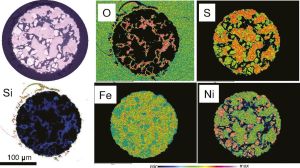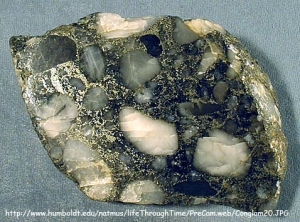
It’s great pleasure to share that former Professor of Earth Sciences at Memorial University, Dr. Hank Williams, was recently announced as one of the 2016 inductees into the Canadian Mining Hall of Fame. Hank has received many tributes in his career, including an outstanding new book “Realtime Geological Syntheses: Remembering Harold ‘Hank’ Williams” by the Geological Association of Canada, but his induction into the Canadian Mining Hall of Fame is particularly satisfying as Hank was not an Economic Geologist, nor was he directly involved in mining or mineral exploration. Despite this, his work had great influence on our understanding of geological and tectonic processes, which in turn had significant impact on mining and mineral exploration.
The nomination was a collective effort between colleagues Frank Blackwood, Peter Dimmell, and I, and we received numerous letters of support from other colleagues that were critical to the nomination’s success. I would like to thank all letter writers: Dr. Jim Franklin, Dr. Jeremy Hall, Dr. John Hanchar, Mr. Bob Kelly, Dr. Tom Lane, Dr. Bill Mercer, Mr. Gerry Squires, Dr. David Strong, Dr. Scott Swinden, Dr. Geoff Thurlow, Mr. Roger Wallis, and Dr. Richard Wardle. In addition, Dr. Bill Roscoe is thanked for his support during the nomination process.
Outlined below is an edited version of the nomination presented here as a tribute to Hank, but also to illustrate how Hank’s basic geological observational data and big picture thinking were relevant not only to understanding geological processes, but also had a longer term impact on mineral exploration and development.
Dr Harold (Hank) Williams (1934-2010), FRSC – Nomination for the Canadian Mining Hall of Fame
Dr. Harold (Hank) Williams was one of Canada’s most preeminent geoscientists . His work greatly influenced the thinking of generations of geoscientists, especially those working in regional mapping and metallogeny.
His fundamentals-based approach to Geoscience through mapping, regional geological synthesis, and tectonic reconstructions of mountain belts laid the framework and thought processes behind predictive metallogeny. This approach to mineral discovery has become a fundamental tool that has led to exploration and development successes in Canada, and continues to be used in the modern mining and exploration sectors globally. While Hank was not a classic Economic Geologist, nor directly involved with the mining industry, his work and the extensions of this work provided fundamental geological knowledge used in modern mineral exploration and mining.
Career Overview, Contributions, and Legacy
Dr. Hank Williams was born in St. John’s, Newfoundland, and obtained BSc (1956) and MSc (1958) degrees from Memorial University. He undertook a PhD at the University of Toronto (1961); his thesis involved geological mapping and metamorphic work in the Chisel Lake area, host to numerous deposits in the Snow Lake Mining Camp. His thesis results were published as maps, a Geological Survey of Canada (GSC) Memoir, and an article in the Canadian Mining Journal. This work was instrumental in putting the important deposits of the Chisel Lake area in regional context and, to the surprise of many, he argued that the massive sulfides were exhalative, not replacement deposits as was in vogue at the time. Following his PhD, Hank became a geologist in the Appalachian Section of the Geological Survey of Canada where he undertook regional mapping in various locations in the Appalachians. During his time at the GSC, he published a seminal paper entitled “The Appalachians in Northeastern Newfoundland: A Two-Side Symmetrical System” in the American Journal of Science (1964). His 1964 paper, and his 1967 synthetic geological compilation map of the Island of Newfoundland, were landmark contributions. They were the first on-land syntheses of an orogenic belt to be placed in a plate tectonic framework. The theory of plate tectonics was in its infancy at this point, and Hank’s work in Newfoundland greatly influenced the work of others, including Canadian Mining Hall of Famer Dr. J. Tuzo Wilson. Dr. Wilson went on to publish his landmark paper (Nature, 1964) on the opening and closing of the Atlantic after Hank’s 1964 publication. Hank’s on-land contributions were synchronous with Wilson and others, and they were critical in moving the plate tectonic revolution forward.
In 1968 Hank moved back to St. John’s to become an Associate Professor in the newly rejuvenated Department of Geology at Memorial University. Hank continued his research in the Appalachians, often in conjunction with the GSC, and was promoted to Professor in 1971, University Research Professor from 1984-1989, Alexander Murray Professor from 1990-1995, and then as a Professor until his official retirement in 1999. During his time at Memorial Hank received numerous awards. He was one of the youngest individuals to be elected as a Fellow of the Royal Society of Canada, and was also awarded the Miller Medal from the same group for his contributions to geoscience. He was also awarded the Logan and Past President’s Medal of the Geological Association of Canada; the R.J.W. Douglas Medal and Special Service Medal of the Canadian Society for Petroleum Geologists (it being recognition from the oil industry of the impact of his tectonic syntheses on petroleum exploration); and was named University Research Professor from 1984-1989 at Memorial University, an award given only to the top researchers.
The numerous awards received reflected the ground-breaking work that he undertook at Memorial. One of his greatest contributions was his synthesis of the Appalachian mountain chain from Alabama to Newfoundland, published in 1978 (Tectonic – Lithofacies Map of the Appalachian Orogen) by Memorial University. This map was one of the first continental-scale compilations of an ancient orogen, and it was the geological basis for his 1979 paper in the Canadian Journal of Earth Sciences (Appalachian Orogen in Canada – cited over 450 times). The lithofacies map and paper provided a new approach to subdividing orogens based on the assemblages of rocks and their tectonic affinities; this significantly influenced the suspect terrane and tectonic assemblage concept that was utilized in many orogens globally (e.g., Cordillera – Coney et al., 1980 – Nature). In addition to his synthesis work, Hank contributed greatly to understanding the emplacement of ophiolites, rift-drift transitions and the breakup of continents, collisional and accretionary tectonics, and the significance of mélanges in orogenic belts. He continued to produce papers and maps into his retirement, including editing the Decade of North American Geology volume on the Appalachians. In one of his final papers (Tectonics of Atlantic Canada – Geoscience Canada), he wrote about the “Harry Hibbs Effect” named after well-known Newfoundland accordion player Harry Hibbs. Hank compared the geological formation of Atlantic Canada to the opening and closing of an accordion, whereby the opening and closing of oceans resulting in the formation of the Grenville and Appalachian orogens, and the modern Atlantic Ocean.
The Harry Hibbs Effect illustrated Hank’s ability to take complex information, synthesize it, and make it accessible not only to scientists, but the general public. Hank gave public lectures on the Appalachians to numerous community groups up until his death in 2010. While formally talking about geology and tectonics, after the talks he would also commonly play various instruments and entertain audiences with his musical talents. His innate ability to connect on both a professional and personal level allowed his message about the Appalachians and Geoscience, in general, to be well received by diverse audiences, thereby increasing the impact of our discipline on the general public.
Impact on Canadian (and Global) Mineral Exploration and Mining
Dr. Williams’ work influences mining and mineral exploration in Canada and globally. Hank was a preeminent field geologist whose work was based on careful field observations, and then using these outcrop-scale relationships to decipher regional tectonics and the evolution of the Appalachian-Caledonian Orogen, from southern US to Scandinavia. His groundbreaking synthesis and tectonic lithofacies map of the Appalachians was one of the first of its kind globally and provided one of the first plate tectonic syntheses of an ancient orogen. His map placed different mineral deposit types, ranging from massive sulfide (e.g., Bathurst, Buchans, ophiolite-hosted VMS deposits), carbonate-hosted Pb-Zn (e.g., Daniel’s Harbour), to syngenetic and orogenic gold deposits (e.g., Carolina Slate Belt, Meguma, Baie Verte district), in a regional tectonic context, which had never been done in the Appalachians, or in other orogens globally. As stated in the support letter of Mr. Gerry Squires, modern mineral exploration “lives and dies with the compilation”, and Hank’s compilation of the Appalachians, born from careful observations, coupled with his geological insight and innovation, has significantly influenced exploration geologists in the Appalachians. It helped them focus their exploration strategies and define explore targets, which ultimately resulted in the discovery of new deposits, some of which have subsequently gone into production (e.g., past-producing Duck Pond mine).
Hank’s regional tectonic synthesis, placing deposits in a plate tectonic framework, was groundbreaking, influencing many of his colleagues in academia, government, and industry, and it was the seed for the concept of regional metallogeny. Up to this time most Economic Geologists did not think of ore deposits in a regional tectonic context, and his research resulted in the dawn of predictive metallogeny and a greater understanding of the regional to local scale controls on ore deposit localization. Industry luminaries embraced this concept utilizing it for area selection, global terrane selection, thereby cementing regional metallogeny as an important component of research and exploration (e.g., Dr. Richard Hutchinson (a CMHOF inductee), 1973 – Economic Geology on VMS and Their Metallogenic Significance; Dr. David Strong – 1976 – Metallogeny and Plate Tectonics; Dr. Duncan Derry (a CMHOF inductee) – 1980 -World Atlas of Geology and Mineral Deposits). The Appalachians and Hank’s work thus became the example of how to link regional mapping and tectonic syntheses to metallogeny. Furthermore, Hank’s integrated approach became the basis for numerous government and industry-funded projects that have been of great significance to the mining industry of Canada and Canadian Geoscience, including:
Hank has also been responsible for training a generation of geologists to read the rocks, training both undergraduate and graduate students to use field relationships, obtained through mapping and outcrop-scale observations, to understand processes on regional tectonic scales. His cross-island fieldtrips of the Newfoundland Appalachians allowed student, industry, and government geologists to understand how to tackle the synthesis of an orogenic belt, such that the Newfoundland Appalachians has become a key field location for students and professionals to understand tectonic processes and where mineral deposits fit into a regional tectonic framework. Hank taught and trained his students with an enthusiasm and excitement for the rocks that was unparalleled, and influenced a generation of students that had a real interest in rocks and relationships (i.e., mapping skills), not just laboratory or computer-based information. These skills and thinking were critical in creating geologists, many of whom went into industry, and utilized their knowledge in exploration and mining. Furthermore, he created a legacy of mentorship, both at Memorial University and in his former students, that continues to be passed on: in that field observations, geological relationships, and geological maps remain the fundamental building blocks of effective mineral exploration and development.
Summary
Dr. Harold Williams is the father of the synthesis of ancient orogenic belts and placing them in a regional tectonic framework.
His work was the seed that spawned the concept of regional metallogy, and of using tectonic lithofacies assemblages for predicting potentially fertile ground for mineral exploration and development. In some cases, this work led directly to deposit discoveries and eventual mines (e.g., Duck Pond mine). His scientific endeavours were paralleled by a career of training geoscientists and influencing his peers to use field observations, mapping, and intellectual intuition to understand the evolution of orogenic belts and the mineral deposits in them.
This has been a great benefit to our country and to the mining and mineral exploration industry of Canada. He has made outstanding Technical and Supporting Contributions (categories 2 and 3) to Geoscience knowledge, and is a more than worthy candidate for the Canadian Mining Hall of Fame.
Stephen J. Piercey, R. Frank Blackwood, and Peter M. Dimmell.


























